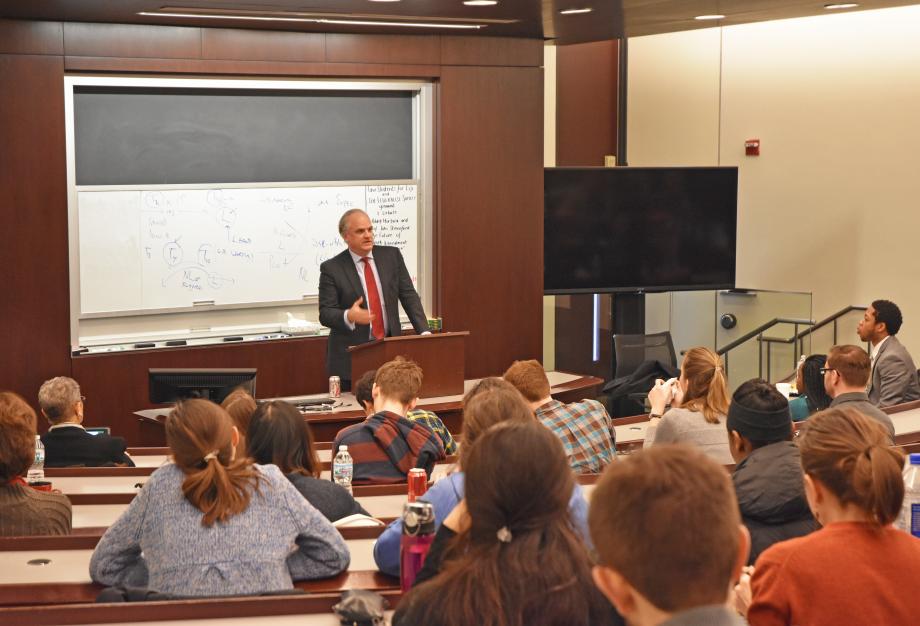Celebrating Black History Month

For decades after the Emancipation Proclamation formally ended slavery, African Americans were victims of a criminal justice system designed to suppress their freedom and equality—and this legacy is still evident in today’s criminal justice system, a Pulitzer-prize winning author told a Law School audience in a talk that was a part of the Black Law Students Association’s (BLSA) Black History Month programming.
“We have a criminal justice system that has evolved a great deal but it is a system that for a century was intended to have a different set of outcomes for different people,” said Douglas Blackmon, the author of Slavery by Another Name: The Re-enslavement of Black Americans from the Civil War to World War II. “It was designed to give white people justice and black people quasi-justice.”
The talk was one of seven programs hosted by BLSA as part of its annual celebration of Black History Month in February. Carter G. Woodson and Jesse Moorland, founders of the Association for the Study of Negro Life and History, created Black History Month, originally Negro History Week, to celebrate African Americans’ achievements during a time when their stories were seldom shared in public. Among the other programs BLSA hosted were “Uncovering the Voting Rights Act in Shelby,” “Police Brutality: Deconstructing Criminal Justice and Race Issues,” and “Doing Business in Africa.” Other organizations including ACS, Defenders, and the Doctoroff Business Leadership Program co-sponsored some of the events.
In his talk, Blackmon gave the audience insight into the system of neo-slavery in the South that was designed to force black Americans into an antebellum version of slavery.
“It was very widespread in the South that prisoners would be sold to a private corporation to pay off their time by working in quarries, mills and other industrial settings,” he said. “If you took a trip across Georgia, you would see everywhere black men chained together and whiplashed, a scene far more terrible than what was experienced by these men’s ancestors.”
The laws enacted by legislatures in the South made it easy to criminalize black life, Blackmon added. “It was a crime to speak loudly in the presence of a white woman, and it was a crime to walk along railroad lines. The most insidious, however, of all these laws was that it was a criminal offense to be unemployed.”
Therein lay the difficulty. How could you prove you were employed if you were barely paid, and when you were, it was in cash? Blackmon’s research showed that the only admissible evidence was for a white landowner to step up and say, “Yes, this is my Negro.” The alternative was a vagrancy charge by the state.
Blackmon argued that the debilitating laws in the South were passed deliberately and intentionally—and that they explain why there is still a large disparity between African American and white communities.
“Up until the mid-1940s, slavery was not a crime,” Blackmon said. “You could challenge a law that was rooted in the idea of old-fashioned slavery on constitutional grounds but there was no statute to cite to . . . It wasn’t until the federal code was extensively re-written that slavery was outlawed. Some things that seem incredibly obvious in our legal system are not.”
The conversation with Blackmon set the stage for the panel discussion on aggressive policing hosted by BLSA and moderated by Ruby Garrett, ’16, the following Monday. The panelists—Clinical Professor Craig Futterman, Director of the Civil Rights and Police Accountability Clinic; Jamie Kalven, journalist and writer at the Invisible Institute; Gladyse Taylor, Assistant Director of the Illinois Department of Corrections; Eugene Munin, General Counsel of the City Colleges of Chicago; and Bob Strickley, journalist at the Cincinnati Enquirer— identified the “code of silence” among police officers as a primary barrier in separating good officers from abusive ones. They also discussed the impact that punitive sentencing guidelines for drug-related offenses have had on mass incarceration.
“In the 1970s, new legislation targeted drug-related offenses. New prisons were built and there was a decade-upon-decade increase in the prison population,” Taylor said. “There are now 46,000 offenders in custody with an average sentence length of 14 years.”
Even if this spigot is turned off, it does not address the need for the reintegration of released prisoners into society, she said. “California is poised to release 30,000 prisoners over the next year. I question that because there is no support system . . . to accept them back into the community.”
Stepping back from the problem and searching for solutions, the audience at both talks asked how the criminal justice system could be fixed.
“There is no doubt that the American system is tremendously more fair than it was then . . . but it is an absurdly draconian system,” Blackmon said. “What we need is not a fairer system but a less draconian system.”
For Futterman, it was a matter of recognizing privilege. “White kids are seven times more likely to use cocaine and sell drugs than black kids,” he said. “But black kids are forty-eight times more likely to go to jail for selling drugs.”
Kalven added: “Fundamentally we know what to do. The only question left is one of political will and values.”
Josephine Oshiafi is the vice president of UChicago’s Black Law Students Association.